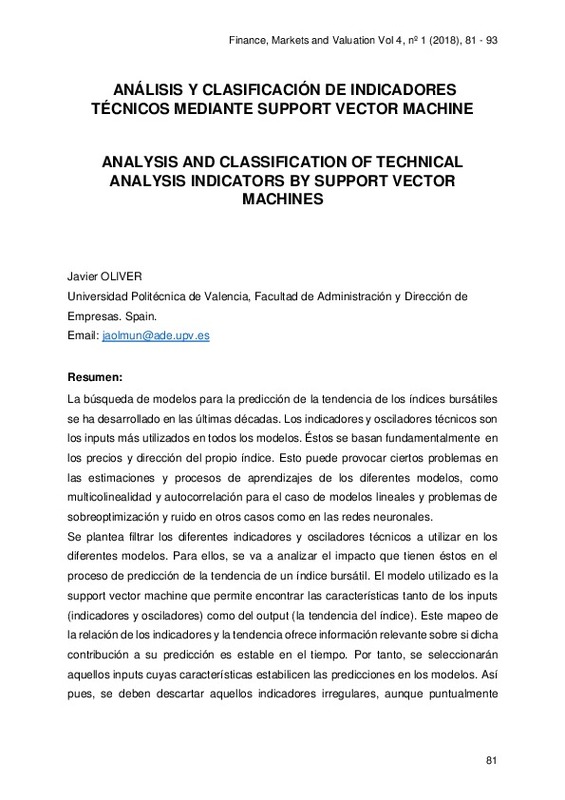JavaScript is disabled for your browser. Some features of this site may not work without it.
Buscar en RiuNet
Listar
Mi cuenta
Estadísticas
Ayuda RiuNet
Admin. UPV
Análisis y clasificación de indicadores técnicos mediante support vector machine
Mostrar el registro sencillo del ítem
Ficheros en el ítem
| dc.contributor.author | Oliver-Muncharaz, Javier
|
es_ES |
| dc.date.accessioned | 2019-06-28T20:04:42Z | |
| dc.date.available | 2019-06-28T20:04:42Z | |
| dc.date.issued | 2018 | es_ES |
| dc.identifier.uri | http://hdl.handle.net/10251/122883 | |
| dc.description.abstract | [EN] The search for models which can accurately forecast the market trend has developed over the past decades. Technical indicators and oscillators are the most usually employed inputs in the prediction models. These inputs basically rely on prices and the evolution of the index itself, which may cause some problems like multicolinearity and autocorrelation, in the case of linear models, or overoptimization and noise, in the case of neural networks. This paper proposes filtering the inputs to be employed in the models. To this end, their impact on the forecast will be analysed. A support vector machine will be used to this end, in order to characterize both inputs (indicators and oscillators) and output (market trend). Doing this, it can be assessed whether the relationship between the different inputs and the market trend offers relevant information regarding the contribution of the inputs in the prediction process and whether this contribution remains constant over time. Those inputs will be selected, which obtain more stable forecasts in order to obtain more consistent predictions. | es_ES |
| dc.description.abstract | [ES] La búsqueda de modelos para la predicción de la tendencia de los índices bursátiles se ha desarrollado en las últimas décadas. Los indicadores y osciladores técnicos son los inputs más utilizados en todos los modelos. Éstos se basan fundamentalmente en los precios y dirección del propio índice. Esto puede provocar ciertos problemas en las estimaciones y procesos de aprendizajes de los diferentes modelos, como multicolinealidad y autocorrelación para el caso de modelos lineales y problemas de sobreoptimización y ruido en otros casos como en las redes neuronales. Se plantea filtrar los diferentes indicadores y osciladores técnicos a utilizar en los diferentes modelos. Para ellos, se va a analizar el impacto que tienen éstos en el proceso de predicción de la tendencia de un índice bursátil. El modelo utilizado es la support vector machine que permite encontrar las características tanto de los inputs (indicadores y osciladores) como del output (la tendencia del índice). Este mapeo de la relación de los indicadores y la tendencia ofrece información relevante sobre si dicha contribución a su predicción es estable en el tiempo. Por tanto, se seleccionarán aquellos inputs cuyas características estabilicen las predicciones en los modelos. Así pues, se deben descartar aquellos indicadores irregulares, aunque puntualmente puedan alcanzar ratios de acierto algo más elevadas que los más estables. Este proceso provocará obtener predicciones de la tendencia más consistentes. | es_ES |
| dc.language | Español | es_ES |
| dc.publisher | Asociación para la Formación y la Investigación en Ciencias Económicas y Sociales | es_ES |
| dc.relation.ispartof | Finance, Markets and Valuation | es_ES |
| dc.rights | Reserva de todos los derechos | es_ES |
| dc.subject | Support Vector Machines | es_ES |
| dc.subject | Tendencia | es_ES |
| dc.subject | Índice bursátil Dow Jones Industrial | es_ES |
| dc.subject | Indicadores técnicos | es_ES |
| dc.subject.classification | ECONOMIA FINANCIERA Y CONTABILIDAD | es_ES |
| dc.title | Análisis y clasificación de indicadores técnicos mediante support vector machine | es_ES |
| dc.title.alternative | Analysis and classification of technical analysis indicators by support vector machines | es_ES |
| dc.type | Artículo | es_ES |
| dc.rights.accessRights | Abierto | es_ES |
| dc.contributor.affiliation | Universitat Politècnica de València. Departamento de Economía y Ciencias Sociales - Departament d'Economia i Ciències Socials | es_ES |
| dc.description.bibliographicCitation | Oliver-Muncharaz, J. (2018). Análisis y clasificación de indicadores técnicos mediante support vector machine. Finance, Markets and Valuation. 4(1):81-93. http://hdl.handle.net/10251/122883 | es_ES |
| dc.description.accrualMethod | S | es_ES |
| dc.relation.publisherversion | https://journalfmv.com/2018_1.html | es_ES |
| dc.description.upvformatpinicio | 81 | es_ES |
| dc.description.upvformatpfin | 93 | es_ES |
| dc.type.version | info:eu-repo/semantics/publishedVersion | es_ES |
| dc.description.volume | 4 | es_ES |
| dc.description.issue | 1 | es_ES |
| dc.identifier.eissn | 2530-3163 | es_ES |
| dc.relation.pasarela | S\359188 | es_ES |






